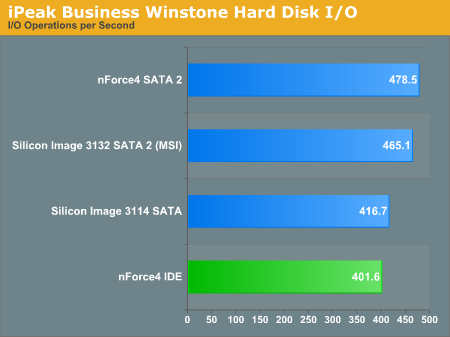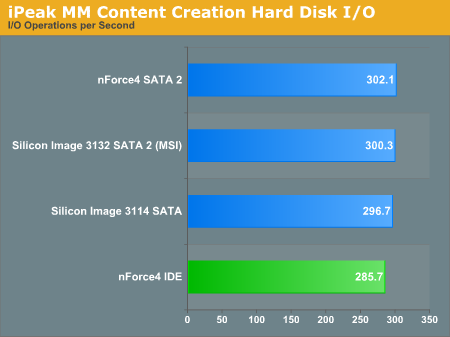nForce4 SLI Roundup: Painful and Rewarding
by Wesley Fink on February 28, 2005 7:00 AM EST- Posted in
- Motherboards
Disk Controller Performance
With so many storage controllers on the nForce4 SLI boards, we needed a means of comparing performance of the wide variety of controllers. The logical choice was Anand's storage benchmark first described in Q2 2004 Desktop Hard Drive Comparison: WD Raptor vs the World. To refresh your memory, the iPeak test was designed to measure "pure" hard disk performance, and in this case, we kept the hard drive as consistent as possible while varying the hard drive controller. The idea is to measure the performance of a hard drive controller with a consistent hard drive. We played back Anand's raw files that recorded I/O operations when running a real world benchmark - in this case, the entire Winstone 2004 suite. Intel's IPEAK utility was then used to play back the trace of all the IO operations that take place during a single run of Business Winstone 2004 and MCC Winstone 2004. To try to isolate performance difference to the controllers that we were testing, we used Seagate 7200.7 model SATA and IDE hard drives for all tests.iPeak gives a mean service time in milliseconds; in other words, the average time that each drive took to fulfill each IO operation. In order to make the data more understandable, we report the scores as an average number of IO operations per second so that higher scores translate into better performance. This number is meaningless as far as hard disk performance is concerned as it is just the number of IO operations completed in a second. However, the scores are useful for comparing "pure" performance of the storage controllers in this case.


The Silicon Image 3114 controller is only a bit slower in MM Content IO, but it is quite a bit slower in Business IO. The 3114 does uniquely feature RAID 3 capabilities and it is featured on 3 of the 4 SLI boards: the Asus, DFI, and Gigabyte.
IDE provided the slowest IO performance in this roundup, demonstrating that SATA controllers are finally starting to show a performance edge - at least in IO operations.
We plan to also include IDE RAID and SATA RAID benchmarks in our future motherboard tests, and comparing RAID performance on various controllers will definitely be a part of future motherboard tests.










108 Comments
View All Comments
fozzymatic - Tuesday, March 1, 2005 - link
"So, is SLI worth the cost and the effort? For some, the answer will be a definite no. The SLI boards still cost a great deal, setting up the system is still a daunting task, and the cost of two top-of-the-line video cards will be just too much for many to consider SLI to be a real option."I still do not understand why this argument is so popular. Why is the general assumption that purchasers of SLI capable boards will immediately want to jump into a dual-card config? The idea is flexibility. Sure, 2 6800's are expensive now, but they will inevitably get cheaper. So why not buy one now and then profit form your forward thinking later down the line when the price of a second card is cut in half and there are more SLI-supported games available. I concede that the mobos are 50$ more than a non-SLI board but, for 50$, I'll take the enhanced upgrade path. Out of the gate the SLI boards are the fastest single or double-card NF4 mobos available, so whats to lose?
justly - Monday, February 28, 2005 - link
Wesley, well done, although I have to admit I skipped over some of the pages describing the individual boards as I am not personnaly intrested in buying a SLI system.One thing about the bar graphs, it could have been a little easier to compare between a single card and SLI if you had used split bars like in this graph
http://images.anandtech.com/reviews/video/ATI/rade...
using the top half of the bar for single card and the bottom for duel cards.
It would also be nice to see a comparasion of disk controller, firewire and USB performance (and anything else that is chipset specific) using all the different brand chipsets.
I don't think you are the person that does power supply reviews, but with all the concerns recenty about power supplies it would also be nice to see an article that not only describes some of the differences in power supplies but what components draw power from what rails and how much they draw (I have seen power supply guides that give an idea of how many total watts is needed but very little information on how those watts are divided up between rails).
One last thing, I have a little problem with this statement "the ability of a motherboard to run at much higher than stock speeds tells you something about the quality of components used in a motherboard". If every motherboad had a perfect BIOS and they all had the same overclocking options then your statement could be true, but that is not the case. Would you call all Intel branded motherboards poor quality just because Intel doesn't put overclocking options in their motherboards BIOS? What if an OEM decided to use one of these great overclocking boards in a prebuilt system and the only change they made to the board was to eliminate the overclocking options from the BIOS, is that board now poor quality?
Viper4185 - Monday, February 28, 2005 - link
Well well well, seems you are right. The MSI nForce 4 Ultra board in Australia even has 1x PCI Express slot...http://www.msi.com.tw/program/products/mainboard/m...
Does anyone know which boards support Firewire 800 (1934b)?
Also to Wesley, thanks for the reply, do you have a rough idea when the nForce 4 Ultra comparison would be available?
falcc - Monday, February 28, 2005 - link
There seems to be different version of MSI's SLI boards depending on where you live. In Australia the SLI board is a MSI K8N Diamond. The interesting thing about this board is that it has two PCI Express x1 slots. as well as the two x16 slots for SLI. It also has a wlan option.falcc - Monday, February 28, 2005 - link
ChineseDemocracyGNR - Monday, February 28, 2005 - link
#43, I'm aware it needs a PHY, but I always thought it worked the same way as it did since the nForce3-250Gb, with no PCI-E involved.I checked out the manual for the MSI K8N Diamond and ASUS A8N-SLI, from them:
MSI
"Dual LAN
? Supports dual LAN jacks
- 1st LAN supports 10/100/1000 Fast Ethernet by nForce4 SLI
- 2nd PCI Express LAN supports 10/100/1000 Fast Ethernet by Marvell 88E8053"
ASUS
"nForce4 built-in Gbit MAC with external Marvell PHY :
- NV ActiveArmor
- NV Firewall
- AI NET2"
I couldn't find a reference that the chipset LAN is tied to PCI-E.
ajmiles - Monday, February 28, 2005 - link
Excellent, thanks Wesley. Every response I've had from now has been, quote:"With regards to the overclockability, it has AI Overclock, PEG link, and other options, the extent of the overclockability was not promised and unfortunately some customers expect amazing overclocking abilities when the 1T overclock is still a good feature and is overclocking in action."
Perhaps what you would expect them to say when their board clocks more than 60mhz lower than some competitors.
If you could keep me apprised of their response either here or at amiles(at)gmail.com that'd be great. Thanks again.
JoKeRr - Monday, February 28, 2005 - link
I really wish MSI could pump a bit more voltage for the ram, 2.85 is a bit low, especially considering the Asus is giving 3V and DFI is giving 4V!! Guess if u want to run your good old BH5 sticks at 250mhz 2-2-2-7, DFI will be the way to go. But I really liked the MSI mobo. o well, guess u can't have everything.JoKeRr - Monday, February 28, 2005 - link
Wesley Fink - Monday, February 28, 2005 - link
#6 & #56 - I saw the same behavior with the A8N-SLI Deluxe during our testing, and I shared my results with Asus. I forwarded your comments and my own to the Asus A8N-SLI BIOS and Engineering team.